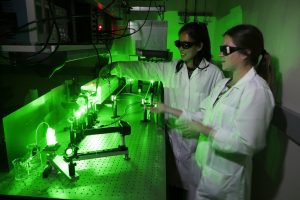At Santa Clara University, located in Silicon Valley, undergraduate students in the Stokes lab are currently monitoring heterogeneous interactions relevant to human health and the environment. Specifically, we are studying the molecular-level interactions of pharmaceutical drugs with supported lipid bilayers using second harmonic generation, fluorescence spectroscopy and circular dichroism.
Research Highlights:
Check out our new Journal of Physical Chemistry B publication which describes how water-soluble N-substituted glycine oligomers (peptoids) adsorb to artificial lipid membranes in order to predict how changes to sequence and 3D structure may alter membrane association. This study was conducted by all undergraduate students!
Our lab received an NSF award CHE-1848583 to support our studies “CAREER: Quantifying How Peptoids Interact with Lipid Membranes.” Funds of $475,000 (2019-2024) will be used to direct and support SCU undergraduate students in the study potentially therapeutic molecule (peptoids). We will use nonlinear optical spectroscopies (second harmonic generation and sum frequency generation) to quantify their interactions with artificial lipid membranes in the presence and absence of transmembrane proteins. For more information, please read this article.
Our lab is also funded by a 2018 Cottrell Scholar Award from the Research Corporation for Scientific Advancement (RCSA). Learn more about our research and educational program supported by RCSA on their website.
With 22 undergraduate co-authors, our 2019 Biopolymers research article describes how peptoids advance multidisciplinary research and undergraduate education in parallel. This peer-reviewed paper describes fluorescence spectroscopy studies of new molecules prepared by students enrolled in a course-based undergraduate research experience (CURE) in Santa Clara University’s introductory organic chemistry lab sequence.
We are currently studying adsorption of water-soluble peptoids to supported lipid bilayers and characterizing the surface chemistry and physical structure of silk fibers from embioptera (webspinners), as described in our 2018 Royal Society Open Science publication.
Check out our 2017 J. Phys. Chem. B publication, which describes how indomethacin, a non-steroidal anti-inflammatory drug commonly used in drug delivery studies, interacts with artificial cell membranes of varying compositions under different physiologically relevant, aqueous pH and salt conditions.
Our 2016 Langmuir paper described how water-soluble peptoids interact with silica surfaces under varying pH and temperature conditions in order to inform design and preparation of novel peptoid coatings.


Recent Comments